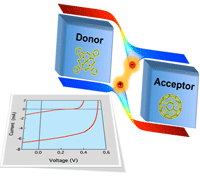New equation could advance research in solar cell materials

(PhysOrg.com) -- A groundbreaking new equation developed in part by researchers at the University of Michigan could do for organic semiconductors what the Shockley ideal diode equation did for inorganic semiconductors: help to enable their wider adoption.
Without the Shockley equation, the computers of today would not be possible.
Developed in 1949 by William Shockley, the inventor of the transistor, the Shockley equation describes the relationship between electric current and voltage in inorganic semiconductors such as silicon.
The new equation describes the relationship of current to voltage at the junctions of organic semiconductors—carbon-rich compounds that don't necessarily come from a biological source, but resemble them. Organic semiconductors present special challenges for researchers because they are more disordered than their inorganic counterparts. But they could enable advanced solar cells, thin and intense OLED (organic light-emitting diode) displays, and high-efficiency lighting.
"The field of organic semiconductor research is still in its infancy. We're not making complicated circuits with them yet, but in order to do that someday, we need to know the precise relationship of current and voltage. Our new equation gives us fundamental insights into how charge moves in this class of materials. From my perspective, it's a very significant advance," said Steve Forrest, the William Gould Dow Collegiate Professor of Electrical Engineering and U-M vice president for research.
Forrest and his doctoral students, Noel Giebink (now at Argonne National Laboratories) and Brian Lassiter, in the U-M Department of Electrical Engineering and Computer Science, contributed to this research. Two papers on the work are published in the current edition of Physical Review B.
About six years ago, researchers in Forrest's lab realized that they could use Shockley's equation to describe the current/voltage relationship in their organic solar cells to a degree.
"It fit nicely if you didn't look too hard," Forrest said.
Their findings were published, and from that time on, many physicists and engineers used the Shockley equation for organic semiconductors even though it didn't describe the physics perfectly. The new equation does.
Forrest says it will allow researchers to better describe and predict the properties of the different organic semiconductors they're working with. And in that way, they'll be able to more efficiently choose which material best suits the needs of the device they're working on.
"People have been investigating organic semiconductors for 70 or 80 years, but we're just entering the world of applications," Forrest said. "This work will help advance the field forward."
The papers are titled, "The Ideal Diode Equation for Organic Heterojunctions. I. Derivation and Application," and "The Ideal Diode Equation for Organic Heterojunctions. II. The Role of Polaron Pair Recombination."
Forrest is also a professor in the departments of Physics, and Materials Science and Engineering. Others contributing to this work are affiliated with Argonne National Laboratory's Center for Nanoscale Materials and Northwestern University.
More information: The papers are titled, "The Ideal Diode Equation for Organic Heterojunctions. I. Derivation and Application," and "The Ideal Diode Equation for Organic Heterojunctions. II. The Role of Polaron Pair Recombination." prb.aps.org/pdf/PRB/v82/i15/e155305 and prb.aps.org/pdf/PRB/v82/i15/e155306
Provided by University of Michigan


















